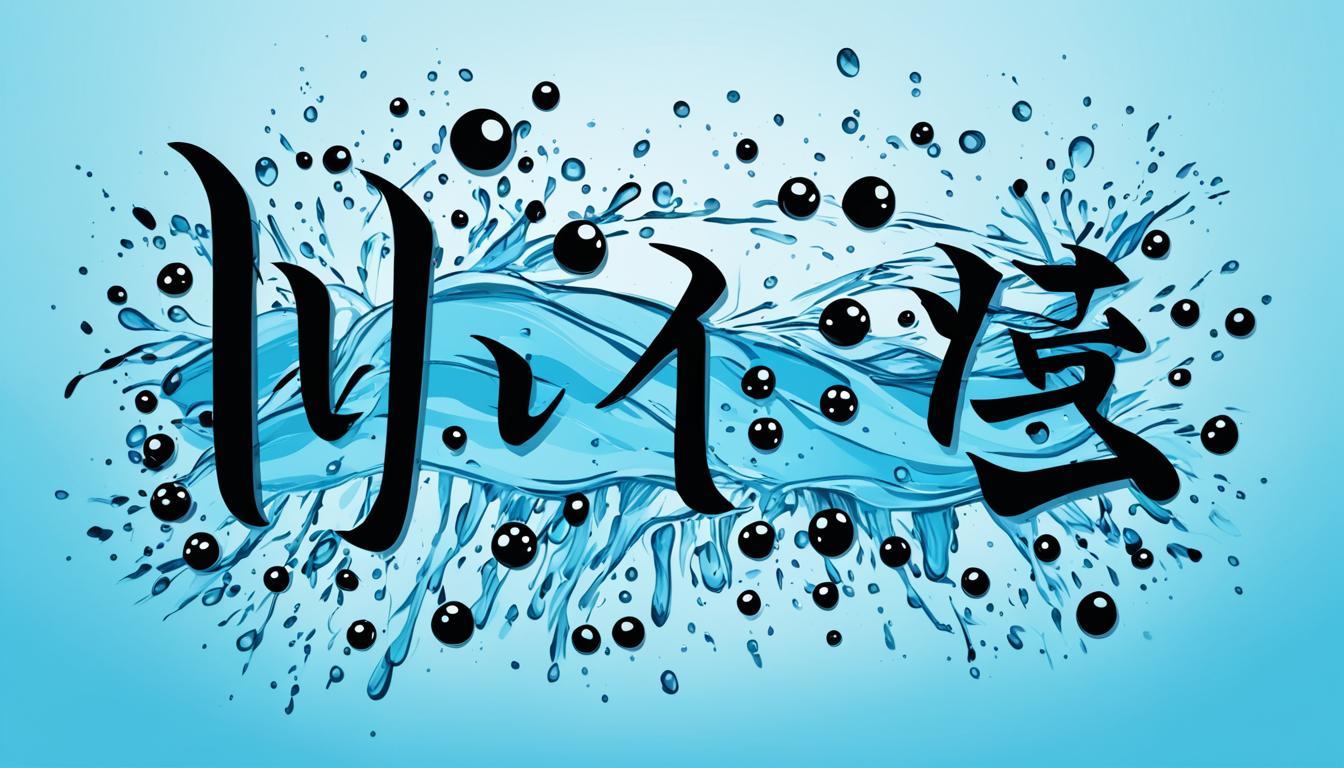Welcome to our quick language guide on how to say “water” in Japanese! If you’ve been curious about the Japanese term for water or want to learn how to write it in Japanese characters, you’ve come to the right place.
In Japanese, the word for water is 水, which is pronounced as “mizu” in English. This kanji, 水, represents the meaning of water and is commonly used in everyday Japanese. It has a stroke count of 4 and is classified as a Joyo kanji, which means it is part of the set of kanji recommended for everyday use.
When it comes to pronunciation, you can confidently say “mizu” when referring to water in Japanese. The hiragana reading for 水 is みず, which can be helpful to know when you encounter this word while reading or writing in Japanese.
Equivalent words for water in Japanese include 水流 (suiru), 湖水 (kosui), and 飲み水 (nomimizu), which respectively mean “water flow,” “lake water,” and “drinking water.” These variations provide added context or specificity when discussing different aspects of water in Japanese.
Writing the word “water” in Japanese characters (kanji) is a fascinating way to explore the language and its rich culture. Here is how it looks:
Understanding and using the word “water” in Japanese can open doors to deeper cultural insights. From traditional tea ceremonies, where water plays a vital role, to appreciating the significance of water in Japanese gardens, this word represents more than just a simple translation. It connects you to the intricacies of Japanese culture and its reverence for nature.
Now that you know how to say and write “water” in Japanese, you can confidently use this word in your conversations or language studies. Explore further and immerse yourself in the fascinating world of Japanese language and culture! Ganbatte (good luck)!
Understanding Japanese Kanji
Kanji are an essential part of the Japanese writing system. They are written characters that were adopted from the Chinese writing system and are used alongside hiragana and katakana to write Japanese. Hiragana and katakana represent the sounds of the Japanese language, while kanji represent the meaning of words and concepts.
Kanji play a crucial role in the Japanese language and are vital for various reasons:
- Understanding everyday things: Kanji is prevalent in Japan, and it’s essential for understanding everyday signs, menus, labels, and other written materials. By knowing kanji, you can navigate through Japanese culture with ease.
- Improving language skills: Learning kanji enhances your language skills and allows you to comprehend written Japanese more effectively. It broadens your vocabulary and helps you express complex ideas.
- Connecting with culture: Kanji is deeply intertwined with Japanese culture and history. By understanding kanji, you can develop a deeper appreciation for Japanese literature, art, and traditions.
In contrast to hiragana and katakana, which primarily represent sounds, kanji characters carry meaning. This makes them an invaluable component of the Japanese writing system.
Continue reading to learn more about kanji, the importance of radicals, tips for learning kanji, and resources available for expanding your kanji knowledge.
Learning Japanese Kanji

Learning Japanese kanji can be a challenging but rewarding journey. To make the process more manageable, you can follow these steps:
1. Learn Basic Kanji: Start by familiarizing yourself with the basic kanji characters and their meanings. One effective method is to associate each kanji with a drawing or picture that represents its meaning. This visual approach can help you remember the meanings more easily.
2. Focus on Common Kanji: Prioritize learning the most commonly used kanji, known as jouyou kanji. These are the kanji that Japanese children learn first and are crucial for everyday communication. By focusing on these essential characters, you can build a strong foundation in reading and understanding the Japanese language.
3. Practice Writing and Stroke Order: It’s important to practice writing kanji and learning their proper stroke order. This will aid in your memorization and improve your reading skills. There are various online resources and apps that provide stroke order guides to help you master this aspect of kanji learning.
4. Supplement with Vocabulary: Enhance your kanji learning by supplementing it with relevant words and vocabulary that are important to you. By connecting kanji with words you frequently encounter or use, you can reinforce your understanding and application of kanji in real-life situations.
Learning kanji is a journey that requires dedication and practice. By breaking it down into manageable steps and utilizing various techniques, you can gradually build your proficiency in reading, writing, and understanding kanji characters.
Understanding Kanji Radicals
Kanji radicals are the building blocks of complex kanji characters. By understanding the role of radicals, you can unlock the meaning behind kanji and enhance your language comprehension. Radicals provide important clues to the meaning of kanji, even if they change shape when used in different characters.
For example, let’s take the radical 水 (water). This radical is commonly used in kanji related to water or liquids. By recognizing this radical within a kanji character, you can make informed guesses about its overall meaning or pronunciation.
Recognizing radicals in kanji allows you to break down the characters and decipher their individual components. This understanding helps you to grasp the meaning of unfamiliar kanji and aids in memorization. By learning the common radicals and their associations, you’ll develop a deeper understanding of the kanji system and improve your overall language skills.
Tips for Learning Kanji
When learning kanji, there are various techniques and strategies that can help you effectively master these complex characters. Here are some tips to enhance your kanji learning journey:
1. Practicing Stroke Order
Practicing the correct stroke order when writing kanji is essential for memorization and improving your handwriting. By following the prescribed stroke order, you develop muscle memory and create a strong foundation for mastering kanji. Consistent practice will enhance your ability to write kanji accurately and efficiently.
2. Using Flashcards with Spaced Repetition Technology
Flashcards are a powerful tool for kanji practice, and when combined with spaced repetition technology, they become even more effective. Spaced repetition involves reviewing flashcards at optimal intervals to reinforce your memory. Several mobile apps and online platforms offer flashcards with built-in spaced repetition algorithms, making it easy to practice kanji anytime, anywhere.
3. Breaking Down Kanji into Radicals
Kanji characters are composed of radicals, which are smaller, meaningful components. Breaking down kanji into radicals helps you understand their meanings and aids in memorization. By recognizing common radicals and their associated meanings, you can decipher the meaning or pronunciation of unfamiliar kanji characters more easily.
4. Consistent Practice and Exposure
Consistency is key when learning kanji. Set aside dedicated time each day to practice reading, writing, and reviewing kanji. The more you expose yourself to kanji through reading books, articles, and other materials, the more familiar and comfortable you become with their forms and meanings. Regular practice and exposure will gradually build your knowledge and proficiency.
| Technique | Description |
|---|---|
| Practicing Stroke Order | Follow the correct stroke order when writing kanji to enhance memorization and improve handwriting. |
| Using Flashcards with Spaced Repetition Technology | Utilize flashcards with spaced repetition algorithms to reinforce your memory of kanji characters. |
| Breaking Down Kanji into Radicals | Understand and recognize the radicals within kanji to aid in memorization and understanding. |
| Consistent Practice and Exposure | Dedicate regular practice time and expose yourself to kanji materials to build knowledge and proficiency. |
Resources for Learning Kanji
When it comes to learning kanji, there are several resources available that can support your journey. Whether you prefer books, online courses, or smartphone apps, finding the right tools can greatly enhance your kanji learning experience.
If you prefer a structured approach and enjoy studying from books, the “Kanji book for Japanese learners” is a highly recommended resource. This book provides a comprehensive guide to studying kanji, offering clear explanations and practice exercises to reinforce your learning.
For those who prefer online learning, “Japanese Uncovered” is an excellent online course that uses storytelling and immersive methods to teach kanji in a natural and engaging way. Through interactive lessons and real-life scenarios, you can develop a deep understanding of kanji and its usage in everyday situations.
Furthermore, if you prefer to learn on the go or integrate kanji practice into your daily routine, smartphone apps can be incredibly convenient. Apps like Anki and Flashcards Deluxe use spaced repetition technology to help you memorize kanji efficiently. With these apps, you can create personalized flashcards and practice kanji anytime, anywhere.
Remember, everyone learns differently, so it’s important to explore various resources and find the ones that best suit your learning style. By utilizing the right tools and consistently practicing kanji, you can make significant progress in your language journey. So go ahead, discover the resources that resonate with you and embark on your kanji learning adventure!

